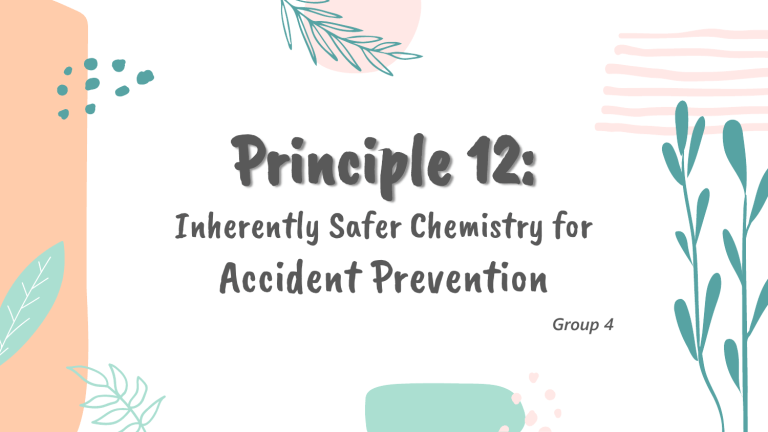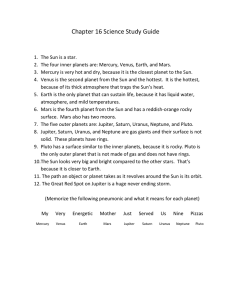
Principle 12: Inherently Safer Chemistry for Accident Prevention Group 4 Table Of Contents 01 Introduction 03 Process Intensification (Minimization) name 05 name name 02 Substitution 04 Attenuation name Limitation of effect name 06 Simplification name 01 Introduction Inherently Safer Chemistry for Accident Prevention: Compounds and processes for forming compounds used in chemical processes must be selected to minimize the possibility of chemical accidents, including releases, explosions, and fires. Why Inherently Safer Design Important? Flixborough, England (1974) a large release of cyclohexane from a caprolactam plant Pasadena, Texas (1989) a leak of gas from a polyethylene plant Bhopal, India (1984) the worst disaster in the history of the chemical industry • Inherent - “existing in something as a permanent and inseparable element...” safety “built in”, not “added on” • Eliminate or minimize hazards rather than control hazards. • “Safer,” not “Safe” Hazard: An inherent physical or chemical characteristic that has the potential for causing harm to people, the environment, or property. Hazards are intrinsic to a material, or its conditions of use. Examples: • Phosgene - toxic by inhalation. • Acetone – flammable. High pressure steam – potential energy due to pressure, high temperature. • Traditional safety approach “Add on” safety features ○ Prevent - alarms, safety interlocks, procedures, training. ○ Mitigate – sprinkler systems, water curtains, emergency response systems and procedures. Inherently safer design Eliminate or significantly reduce process hazards. Limit effects by design, location or transportation of equipment so that the worst possible condition produces less danger. Error tolerance Minimization Reducing the amount of hazardous material present at any one time. Principles Substitution Equipment and processes can be designed to be capable of withstanding possible faults or deviations from design. Simplification Replacing one material with another of less hazard. Eliminating problems by design rather than adding additional equipment or features to deal with them. Moderation Reducing the strength of an effect. 02 Process Intensification (Minimization) Process Intensification (or minimization) Key goal: Reduction of unit operations and chemical plants. 11 Benefits of PI Major Cost Saving Safer Processes Smaller Equipment/ Plant High Product Purity Short time to the Market High Selectivity Operational Excellence Quality by Design Less waste/ by products Process Intensification in Reactors • • Reactors refer more scope for reduction. All types of reactors are large not a large output output is desired, but because conversion is low, reaction is slow, or both. What controls chemical reaction? Heat removal. Mass transfer (mixing or between phases/across surfaces). Chemical equilibrium. The process itself. Example: Nitroglycerin Production • Reaction is highly exothermic • Usually 2 liquid phases – an aqueous/acid phase and an organic/solvent phase. The rate of the reaction is controlled by: • Mixing – bringing reactants into contact with each other • Mass transfer – from acid/aqueous phase (nitric acid) to organic phase (organic substrate) • Heat removal Catalyst (usually sulfuric acid) feed or pre-charge Nitric acid gradual addition Organic Substrate and solvents pre-charge Batch Reactor ~6000 gallons CSTR Nitration Process Raw Material Feeds Decrease the probability that any risk can happen. Organic substrate Catalyst Nitric Acid The conversion will be higher. Reactor ~ 100 gallons Product 03 Substitution Substitution • Substitute a less hazardous reaction chemistry • Replace a hazardous material with a less hazardous alternative. Substitute materials Water based coatings and paints in place of solvent based alternatives: • Reduce fire hazard • Less toxic • Less odor • More environmentally friendly • Reduce hazards for end user and also for the manufacturer Substitution- Refrigeration pre 1930 1930s Toxic, flammable refrigerants Inherently safer alternative (CFCs) 1980s Discovery of environmental problems Reaction Chemistry- Acrylic Esters • • • Acetylene - flammable, reactive Carbon monoxide - toxic, flammable Nickel carbonyl - toxic, environmental hazard (heavy metals), carcinogenic • • Anhydrous HCl - toxic, corrosive Product - a monomer with reactivity (polymerization) hazards Reppe Process: 𝐍𝐢 𝐂𝐎 𝟒 𝐇𝐂𝐥 𝐂𝐇 ≡ 𝐂𝐇 + 𝐂𝐎 + 𝐑𝐎𝐇 𝐂𝐇𝟐 − 𝐂𝐇𝐂𝐎𝟐 𝐑 Alternate Chemistry Propylene Oxidation Process Inherently safe? No, but Inherently safer THANK YOU FOR LISTENING 456 Venus is the second from the Sun 20 Mars is actually a very cold place 300 Jupiter is the biggest planet Two Simple Actions Mercury Mercury is the closest to the Sun and the smallest one in the Solar System—it’s only a bit larger than the Moon Venus Venus has a beautiful name and is the second planet from the Sun. It’s hot and has a poisonous atmosphere Three Ways To Use Less Plastic Mercury It’s the closest to the Sun and the smallest in the System Venus Venus has a beautiful name and is the second from the Sun Mars Despite being red, Mars is cold. It’s full of iron oxide dust How To Consciously Consume Venus Jupiter Venus is the second planet from the Sun It’s the biggest planet in the Solar System Mars Saturn Despite being red, Mars is a cold place Saturn is a gas giant and has several rings 150,000 Big numbers catch your audience’s attention Awesome Words A Picture Is Worth A Thousand Words A Picture Always Reinforces The Concept Images reveal large amounts of data, so remember: use an image instead of a long text. Your audience will appreciate it Eco-Friendly Countries Mars Mars is actually a very cold place Neptune It’s the farthest planet from the Sun Saturn It’s composed of hydrogen and helium Eco-Friendly Brands 10% 35% 25% 30% Venus is the second planet from the Sun Saturn is composed of hydrogen Mars is actually a very cold place Jupiter is the biggest planet To modify this graph, click on it, follow the link, change the data and paste the new graph here, replacing this one. You can see how to modify the graph here RRR Recyclable Reusable Reduce Glass Mercury is the closest planet to the Sun Jupiter is the biggest planet of them all Venus is the second planet from the Sun Plastic Saturn is made of hydrogen and helium Mars is actually a very cold place Venus has a nice name, and it’s hot Metal Venus is an extremely hot planet Mars is actually full of iron oxide dust The Earth is the only planet with life Paper Mercury is the smallest planet It was named after the Roman god Saturn is the only planet with rings Principles • Reducing the amount of hazardous material present at any one time • Eg: by using smaller batches. Replacing one material with • Eg. cleaning with water and detergent rather than a flammable solvent another of less hazard Minimization: Moderation: Simplification: Limitation Simplification • Reducing the strength of an effect • Eg. having a cold liquid instead of a gas at high pressure •Eliminating problems by design rather than adding additional equipment or features to deal with them •Changing designs or reaction conditions rather than by adding protective equipment that may fail or be neglected •Using simple plants rather than complex one. 35 Plastic Time Life 01 02 03 04 1 Year 5 Years 20 Years 500 Years Venus is a planet with high temperatures Despite being red, Mars is a cold place Mercury is the closest planet to the Sun Jupiter is the biggest planet of them all Desktop Software You can replace the image on the screen with your own work. Just right-click on it and select “Replace image” Thanks Does anyone have any questions? addyouremail@freepik.com +91 620 421 838 yourcompany.com CREDITS: This presentation template was created by Slidesgo, including icons by Flaticon and infographics & images by Freepik. Please keep this slide for attribution




